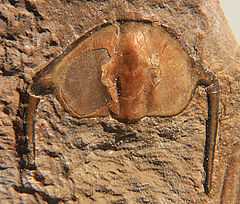Biceratopsinae
From Wikipedia, the free encyclopedia
| Biceratopsinae Temporal range: Toyonian (Upper Olenellus-zone) 516–513Ma | |
|---|---|
 | |
| Emigrantia sp., a cephalon | |
| Scientific classification | |
| Kingdom: | Animalia |
| Phylum: | Arthropoda |
| Class: | Trilobita |
| Order: | Redlichiida |
| Suborder: | Olenellina |
| Superfamily: | Olenelloidea |
| Family: | Biceratopsidae |
| Subfamily: | Biceratopsinae (Pack & Gayle, 1971)[1] |
| Genera | |
| |
The Biceratopsinae is an extinct subfamily of trilobites, fossil marine arthropods, with species of small to average size. Species of belonging to this subfamily lived during the Toyonian stage (Upper Olenellus-zone), 516-513 million years ago, in the former continent of Laurentia, including what are today the South-Western United States and Canada.[4]
Etymology
The Biceratopsinae are named for the type species Biceratops nevadensis.
Habitat
The Biceratopsinae were probably marine bottom dweller, like all Olenellina.
References
- ↑ Lieberman, B.S. (1999). "Systematic Revision of the Olenelloidea (Trilobita, Cambrian)". Bulletin of the Peabody Museum of Natural History 45.
- ↑ M., Webster (2007). "Ontogeny and evolution of the early Cambrian trilobite genus Nephrolenellus (Olenelloidea)". Journal of Paleontology 81: 1168–1193.
- ↑ Webster, M. (2007). "Paranephrolenellus, a New Genus of Early Cambrian Olenelloid Trilobite". Memoirs of the Association of Australasian Palaeontologists 34: 101–130.
- ↑ Pack, P.D.; Gayle, H.B. (2009). "A New Olenellid Trilobite, Biceratops nevadensis, from the Lower Cambrian near Las Vegas, Nevada". Journal of Paleontology 45 (5). pp. 893–898.
This article is issued from Wikipedia. The text is available under the Creative Commons Attribution/Share Alike; additional terms may apply for the media files.